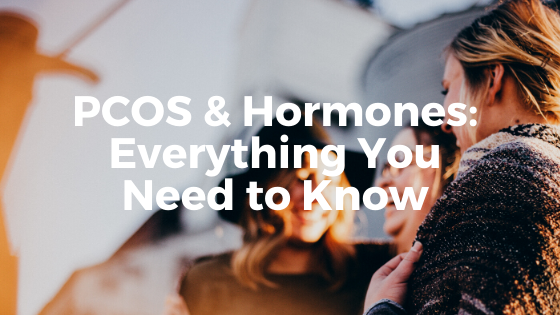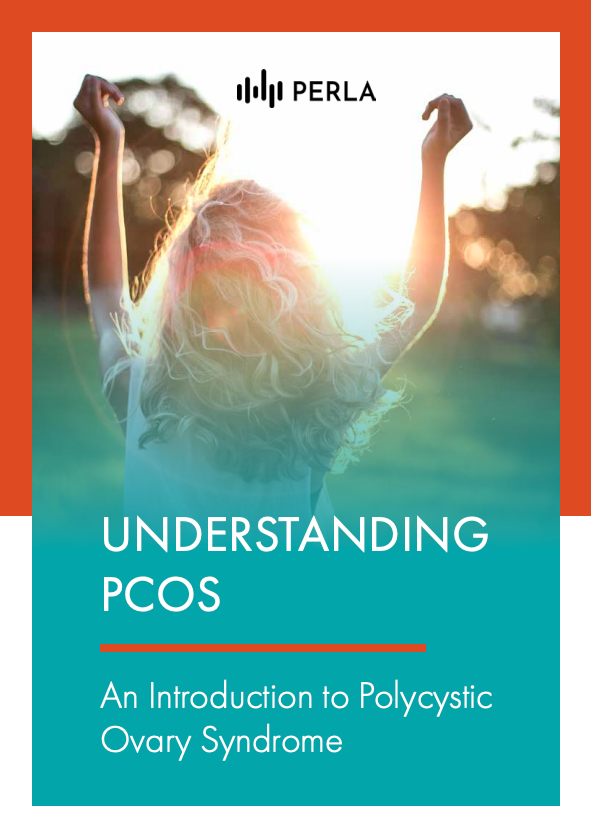Hormones play a big role in PCOS: Even though the exact cause of polycystic ovary syndrome (PCOS) is not fully identified yet, it’s thought to be related to an imbalance in the hormones in the brain and the ovaries. But what exactly is the role of hormones in PCOS? Which hormones are measured, and why? Let’s dive right in:
Hormonal Imbalance in PCOS
A number of hormones influence the signs and symptoms of PCOS – even small changes in hormonal levels can cause notable symptoms. In PCOS, the levels of pituitary hormone called luteinizing hormone (LH) and the levels of insulin in the blood are usually too high.1 This causes the ovaries to make an excessive amount of testosterone. The majority of excess testosterone is produced by the ovaries, but excess androgen can also come from the adrenal glands, which sit on top of the kidneys. High testosterone levels are responsible for the many physical symptoms of PCOS such as facial and body hair growth, acne, and hair loss. Some evidence suggests that it also interferes with the normal function of the ovaries.2
Measuring Hormone Levels
Assessing hormone levels is important to rule out other disorders with similar symptoms and is used in the diagnostic process of PCOS. (see “How PCOS is diagnosed”). One thing to note is that hormone levels in women vary widely. Also, the reference range for some hormones differs between laboratories. It is possible for some women with PCOS to have their hormone levels within the “normal” range while suffering from androgen-related symptoms.
These key patterns of hormonal changes can often be seen in women with PCOS:3
- Increased androgens (testosterone, DHEAS, and androstenedione)
- Increased Luteinizing Hormone (LH)
- Increased prolactin
- Increased estradiol
- Increased insulin
Total and Free Testosterone
All women produce male hormones in their bodies. But if you have PCOS, your body produces a little bit more than the normal amount of testosterone. High LH and insulin levels cause the ovaries to produce more testosterone.
Free testosterone is the amount of unbound or active testosterone in your body. Total testosterone is the total amount of testosterone in your body, including the free testosterone. Women with PCOS usually have elevated levels of both free and total testosterone. Even a slight increase in testosterone can affect a woman’s menstrual cycle and ovulation.4
Luteinizing hormone (LH) and Follicle-Stimulating Hormone (FSH)
Abnormal levels of luteinizing hormone (LH) and high levels of male hormones inhibit the normal function of the ovaries.2 The pituitary gland in the brain produces both LH and FSH and sends them to the ovaries. Normally, there is a large burst of LH, a so-called LH surge, that happens in the middle of the menstrual cycle and signals the ovaries to ovulate. Women with PCOS usually have low to normal levels of FSH, but high levels of LH. Because LH is already high, there is no LH surge that occurs. Without an LH surge, the ovaries cannot release an egg and you may have irregular menstrual cycles.5
Additionally, an imbalance between LH and FSH levels stimulates the inappropriate production of testosterone. High testosterone can interfere with follicular development, contributing to anovulation and irregular menstruation.
Dehydroepiandrosterone sulfate (DHEAS)
DHEAS is another male hormone produced by the adrenal gland, which can be found in all women. Women with PCOS tend to have a slightly elevated level of this hormone. Moderately high levels of DHEAS can also cause androgen-related symptoms such as facial and body hair growth, acne, and hair loss.
Androstenedione
Like testosterone, androstenedione is produced by the ovaries and adrenal glands. Doctors usually measure androstenedione and DHEAS if the total and free testosterone are not elevated. High levels of this hormone can affect the levels of estrogen and testosterone.
Prolactin
Prolactin is the hormone responsible for the production of milk during pregnancy. Mildly elevated prolactin is common in women with PCOS. It may also be necessary to measure this hormone to rule out tumors in the pituitary gland, which can cause PCOS related symptoms.
Progesterone
Progesterone is released by the ovaries after ovulation. Progesterone levels are very important if you are trying to get pregnant using fertility medications. A high level of progesterone signifies that an egg was released. If the level is low, it means the ovulation did not occur.
Estrogen
An adequate amount of estrogen and progesterone is necessary for the regulation of the menstrual cycle. Estrogen is produced in the ovaries, but high levels of testosterone can also be converted to estradiol – the most active form of estrogen. Women with PCOS and high levels of estrogen may experience heavy bleeding during menstruation and are at higher risk of developing endometrial cancer.6
Insulin and Glucose
Due to the recent findings that PCOS is associated with insulin resistance,7,8 it is recommended that women with PCOS, especially those that are obese or overweight, should have an oral glucose tolerance test (OGTT) and a fasting plasma glucose test (FPG).
Other Tests
Depending on clinical suspicions, your doctor may also recommend other tests such as:
- Thyroid-stimulating hormone (TSH) – to exclude thyroid disorders such as underactive or hyperactive thyroid
- Cholesterol and lipids – to assess your risk of developing heart disease
- 24hr urine cortisol – to exclude Cushing’s syndrome
The hormonal imbalance influences the clinical manifestations of PCOS. Hormone tests provide important information about PCOS when applied appropriately. It’s best to follow the advice of your doctor about hormone testing, and take the opportunity to ask your doctor or care team all of your hormone-related questions.
Sources:
- Baptiste CG, Battista MC, Trottier A, Baillargeon JP. Insulin and hyperandrogenism in women with polycystic ovary syndrome. J Steroid Biochem Mol Biol. 2010;122(1-3):42‐52. doi:10.1016/j.jsbmb.2009.12.010
- Barbierri R, Ehrmann D. Patient education: Polycystic ovary syndrome (PCOS) (Beyond the Basics). UpToDate. https://www.uptodate.com/contents/polycystic-ovary-syndrome-pcos-beyond-the-basics. Published 2020. Accessed May 20, 2020.
- Balen A. The current understanding of polycystic ovary syndrome. Obstetrician and Gynaecologist 2004;6:66-74
- De Leo V, Musacchio MC, Cappelli V, Massaro MG, Morgante G, Petraglia F. Genetic, hormonal and metabolic aspects of PCOS: an update. Reprod Biol Endocrinol. 2016;14(1):38. Published 2016 Jul 16. doi:10.1186/s12958-016-0173-x
- Kumar P, Sait SF. Luteinizing hormone and its dilemma in ovulation induction. J Hum Reprod Sci. 2011;4(1):2‐7. doi:10.4103/0974-1208.82351
- Endometrial Cancer Risk Factors. Cancer.org. https://www.cancer.org/cancer/endometrial-cancer/causes-risks-prevention/risk-factors.html. Published 2019. Accessed May 20, 2020.
- Polak K, Czyzyk A, Simoncini T, Meczekalski B. New markers of insulin resistance in polycystic ovary syndrome. J Endocrinol Invest. 2017;40(1):1-8. doi:10.1007/s40618-016-0523-8
- Mitkova Orbetzova M. Clinical impact of insulin resistance in women with polycystic ovary syndrome. In: Wang Z, ed. Polycystic Ovarian Syndrome. IntechOpen; 2020. doi:10.5772/intechopen.90749


